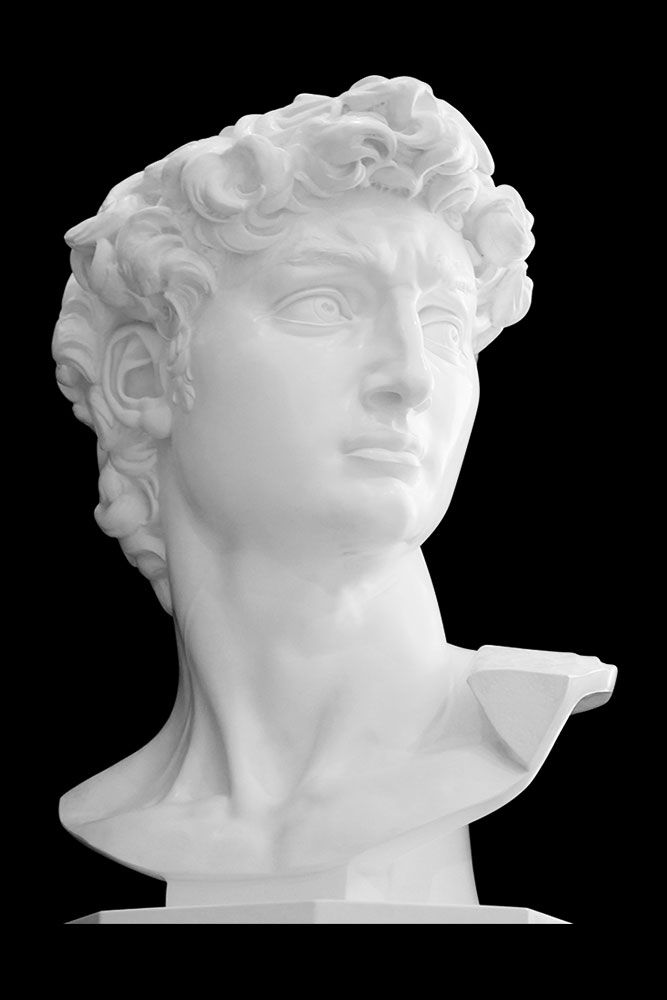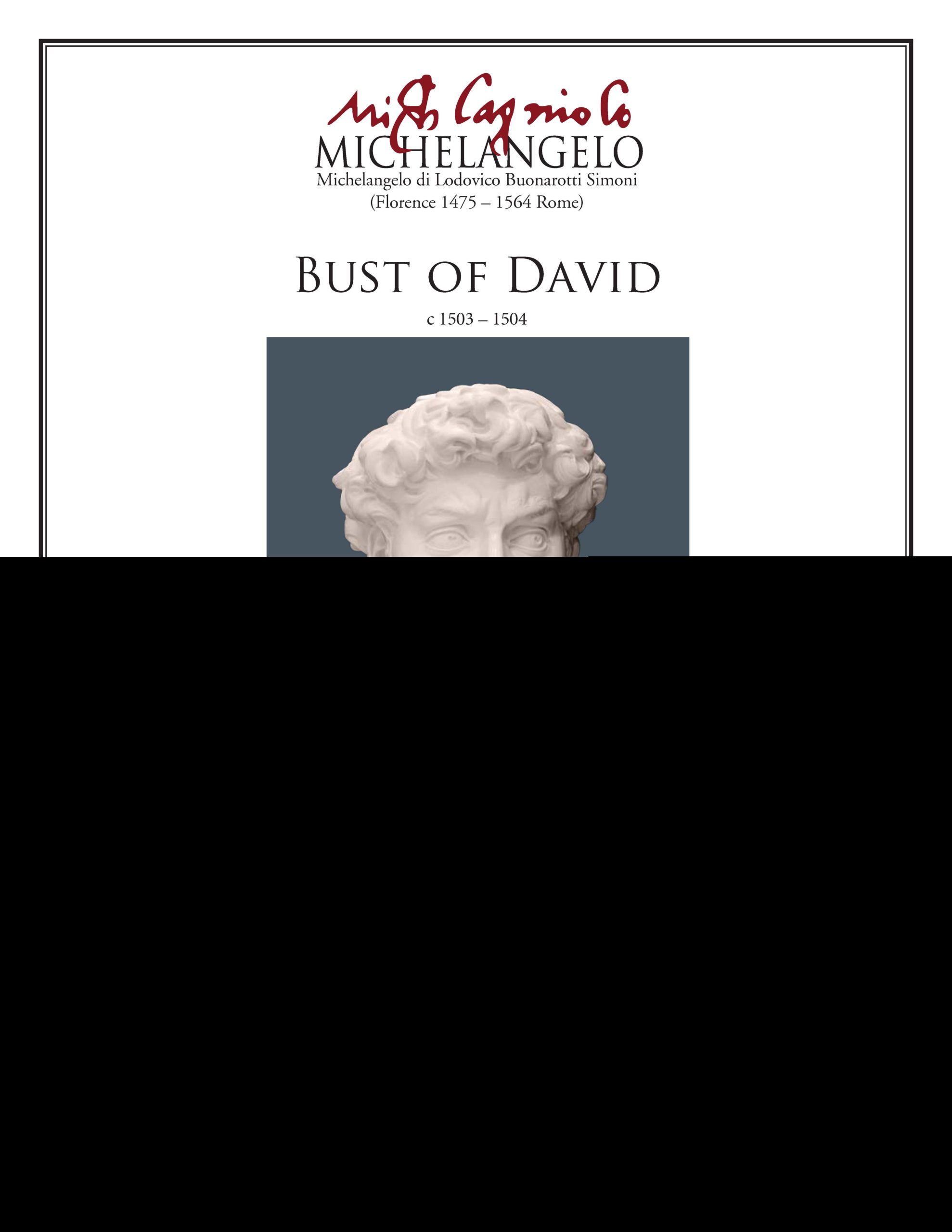HEAD OF DAVID
By Michelangelo
On January 25, 1504, when the sculpture was nearing completion, a committee of Florentine artists, including Leonardo da Vinci and Sandro Botticelli, met to decide on an appropriate site for David. The majority, led by Giuliano da Sangallo and supported by Leonardo and Piero di Cosimo, among others, believed that due to the imperfections in the marble, the sculpture should be placed under the roof of the Loggia dei Lanzi on Piazza della Signoria. Others, such as Botticelli, believed that the sculpture should be situated on or near the cathedral. Eventually, David was placed in front of the entrance to the Palazzo Vecchio, also on Piazza della Signoria, and replaced Donatello’s bronze sculpture of Judith and Holofernes (another theme of heroic resistance). It took four days to move the statue from Michelangelo’s workshop onto the Piazza della Signoria. In 1873, the monumental marble was moved for its protection inside the Accademia Gallery in Florence, where it continues to attract hundreds of thousands of visitors annually. A replica was placed in the Piazza della Signoria in 1910.
Michelangelo di Lodovico Buonarotti Simoni
(Florence 1475 – 1564 Rome)
The David
After the turn of the century, Florence experienced a surge of intellectual renewal. The Italian city state fought hard to re-institute its “constitutional balance and vigor, its territorial authority, and an environment that welcomed the best artists into its service.” It is the expulsion of the religious leader of Savanorola, and the renewal of the Florentine Republic, which made returning to Florence an attractive move for Michelangelo.
The influence of Savonorola was a large catalyst in Michelangelo’s decision to go to Rome in the late 1400′s and ultimately why he stayed for 5 years. In a grand gesture by the people of Florence, Savonorola and two of his supporters were arrested at the Church of San Marco by an angry mob. Savonarola was imprisoned for six weeks in the Palazzo della Signoria, and under extreme torture finally signed a document confessing that all of his revelations were false. In 1448, Savonorola would be burnt at the stake Palazzo della Signoria along with his two supporters and Florence would finally declare themselves a free Republic.
It would be in this new era of Florentine revival that Michelangelo would create the larger than life statue of the David. It would be this statue that would represent the resilient city-state’s symbol of pride and its message to the world that Florence would be a force to be reckoned with. It would be in 1501 that the Florence Cathedral building committee would ask Michelangelo to work on a great block of marble left over from an earlier aborted commission.
According to Michelangelo’s friend Condivi, The commission for the statue the Florentines called the Giant would come about in this way:
“The operai of Santa Maria del Fiore owned a block of marble nine braccia high, which had been bought from Carrara a hundred years earlier by an artist who, from what one could see, was not as experienced as he should have been…he had roughed it out in the quarry but in such a way that neither he or anyone else ever had the courage to lay a hand to it to carve a statue.”
In a note in the margin of Michelangelo’s contract with the Opera del Duomo it states that:
“Michelangelo began to work and carve the Giant on 13 September 1501, a Monday. Previously on the 9th, he had given it one or two blows with his hammer to strike off a certain knot that it had on its chest…which must have been an earlier remnant of the earlier sculptor’s attempt. By knocking it off, Michelangelo declared his independence from the block’s past.”
Michelangelo was well aware of the Republican symbolism of the David. He knew that the intent of the statue was not only to elicit pride from Florentines, but also to bring a sense of Republican obligation to fight for the Italian city-state. “The David has a long symbolic heritage derived not only from Biblical history but also from the antique in its echoes of Hercules triumphing through strength over the labors inflicted upon him by tyranny… [Where Michelangelo] had made a new statement of an old theme, given a new monumentality.” Michelangelo knew that this sculpture was important to not only the physical ambiance of Florence but as a symbolic message to the rest of the world that Florentine Province was a force to be reckoned with.
The monumental sculpture has been described as:
“A Youth, full of latent energy and strength, with huge limbs and a watchful uncertain expression on his sharply delineated features. One massive hand dangles against the right thigh the other raised to hold the sling, so that the long line of the open left-hand silhouette contrasts with the closed forms on the right.”
One aspect of the David that would have stood out to the Renaissance contemporaries of Michelangelo is the scowl of the young hero. In the Bible David was the ‘Lion of Judah,’ and the ancient symbol for Florence was the Lion. In the scowl on David’s face, Michelangelo was using this link to create not just a beautiful piece of art, but also a theological statement about Florence. In an article by David Summers he states that: “a cloudy brow signifies self-will as in the Lion” This was a well-known fact among Renaissance artists and Michelangelo exploited this artistic attribute. Summers goes on to say that: “the clouded-brow, as seen on the David, is the vice of those who little consider the difficulty of some great act, [such as killing Goliath], and presuming too much of their own powers, believe they will easily attain their end.”
As a study in the human form and the Classical nude Michelangelo created in the David the perfect man. His study of human anatomy, in drawing and as a young adult dissecting bodies in Florence no doubt prepared him to complete the masterpiece. Michelangelo has captured the energy of the moment in the marble while using the anatomy of the young hero to express the emotion in this tense moment.
Condivi, in a comment about the David says:
“He received four hundred ducats for this work and he accomplished it in eighteen months. And also there should be no material in the realm of sculpture to which he could not turn his hand, after the Gigante…”
Selected Reference Literature:
Condivi, Vita di Michelangelo Buonarroti…1553; George Bull, Michelangelo: A Biography, 1995; Nathaniel Harris, The Art of Michelangelo, 1983; Robert Coughlan, The World of Michelangelo 1475-1564, 1972; Fred Kleiner and Christian Mamiya, Gardner’s Art Through the Ages: Vol 2, Twelfth Edition Volume II, 2005; Linda Murray, Michelangelo, 1980; David Summers, Life and Early Works of Michelangelo: Selected Scholarship in English Vol 1, 1995.


